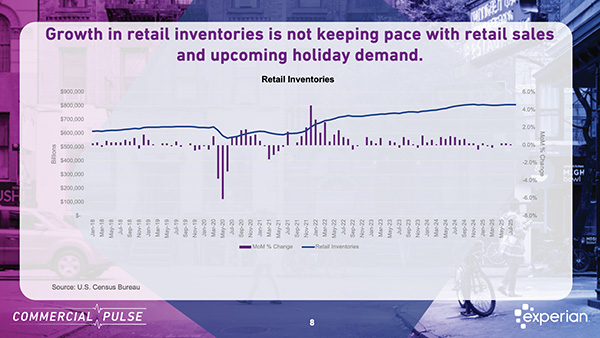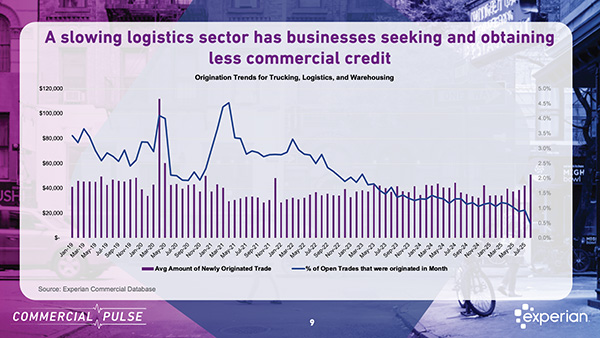Commercial Pulse Report | 4/22/2025
The Experian Commercial Pulse Report, will officially be released on Tuesday, April 22, 2025. This edition focuses on current trade disruption, and the air of uncertainty in the U.S. economy, particularly as it relates to trade policy. While inflation has recently eased and small businesses gained modest ground in February, recent trade developments and softening optimism suggest cautious times ahead—especially for Main Street.
Watch Our Commercial Pulse Update
A Historic Trade Deficit Raises Eyebrows
Let’s start with a stat that might surprise you: The U.S. currently holds a $1.1 trillion trade deficit with just its top 10 trade partners—the highest ever recorded. This staggering gap highlights the country’s heavy reliance on imports, especially from countries like China, Mexico, and Germany.
Even more telling, the U.S. also has a $990 billion trade deficit across its top 10 import categories, ranging from electronics and machinery to vehicles and pharmaceuticals. The lone bright spot? A trade surplus of over $70 billion in mineral fuels and plastics. This imbalance, coupled with a flurry of recently enacted tariffs, has shaken market confidence and raised the stakes for small business supply chains.
Small Business Conditions Improve—Cautiously
Despite the macroeconomic noise, small businesses are showing some signs of resilience. The Experian Small Business Index™ rose by 3.9 points to 45.4 in February, marking the second consecutive monthly gain. While still below the neutral threshold of 60, the index suggests modest recovery in business credit health and access to capital.
Positive trends include:
- Low unemployment (4.2%)
- Cooling core inflation (2.8%)
- Rising existing home sales (+4.2%)
- Steady wage growth (up to $30.96/hour)
Yet, it’s not all good news. Compared to a year ago, the index is still down nearly 9 points. Small business optimism declined sharply to 97.4, dropping below its 51-year average and reflecting growing concern about inflation, policy changes, and the impact of new tariffs.
The Manufacturing Sector: Small but Mighty
One of the more compelling narratives in this month’s report centers on the evolving U.S. manufacturing sector. Once ravaged by outsourcing and automation, manufacturing is now undergoing a quiet transformation, driven largely by small businesses.
Manufacturing shipments, inventories, and orders reached a record $596.8 billion in February 2025. And while total employment has not rebounded to pre-2000 levels, the number of manufacturing businesses has, indicating a new wave of small and mid-sized manufacturers entering the market.
Younger businesses—those less than two years old—now account for:
- Nearly 13% of monthly commercial credit originations, up from less than 1% just a few years ago.
- Outstanding average credit balances of $57,000, almost double from early 2022.
These trends point to an emerging entrepreneurial base in manufacturing, which could reshape the industry’s future.
What to Watch Going Forward
While economic fundamentals show signs of stability, the policy environment is becoming increasingly volatile. Since the new administration took office in January, tariffs have been announced, adjusted, or enacted nearly daily, leading to market swings, rising input costs, and disrupted supply chains. Many small business owners are now operating in a world where trade policy, not just demand or inflation, is directly impacting their bottom line.
Stay Ahead with Experian
- ✔ Visit our Commercial Insights Hub for in-depth reports and expert analysis.
- ✔ Subscribe to our YouTube channel for regular updates on small business trends.
- ✔ Connect with your Experian account team to explore how data-driven insights can help your business grow.



